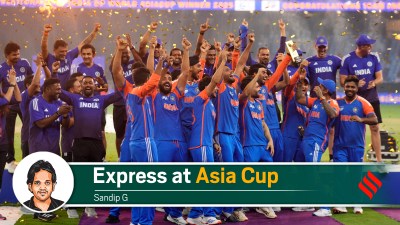Sporting Chance
It began with a discussion late in the afternoon of December 26 2004, hours after the tsunami struck. Those in attendance included ...

| It began with a discussion late in the afternoon of December 26 2004, hours after the tsunami struck. Those in attendance included former Sri Lanka captains Aravinda de Silva and Duleep Mendis. Within 24 hours, Sri Lanka Cricket had set in motion its plan to help those most affected by the worst modern crisis to hit the island. And on January 5 SLC officially launched its Disaster Assistance Fund Cricket Aid scheme, aiming to link orphans with foster parents, selected by national welfare groups. Four relief camps were set up for orphans and/or families affected by the tsunami in Matara, Galle, Batticaloa and Kilinochchi. Since then the programme’s ‘Cricket for Humanity’ motto has caught on with shirts, caps, and other memorabilia sold to swell the fund. Apart from 200-family villages near each of those towns, the plan is to set up infrastructure including education, playground, religious, water and electrical supply as well as sewage system and telephone links. — Trevor Chesterfield |
THE sports facility looked more like an abandoned minefield; sparse in grass covering, a few scrawny goats scavenging for scraps, and used for anything from cricket to volleyball and netball and soccer.
Fronting Highway 9, the main road to Jaffna, the remains of Central Kilinochchi School were 300 metres away. All that was missing were the long stretches of fluttering plastic ribbon demarcating the area where it was not safe to walk.
In these mentally hostile surroundings and in the hot, humid conditions, two former Test players cheerfully held a coaching clinic for Tamil schoolboys, and talked bravely of a bright future for a united Sri Lanka.
When Hashan Tillekeratne and Ruchira Perera — part of Sri Lanka’s Cricket Aid team — swept up Highway 9 and into the dusty Tamil Tiger stronghold of Kilinochchi, with their ‘Cricket for Humanity’ theme, there were none of the happy throngs that had warmly greeted them in Matara, Galle or Batticaloa.
Not that cricket is as foreign as some would have you believe. On the way in, a couple of kilometres beyond the well-manned LTTE checkpoint, we spied a game going on in what could have only been a demined area. But it was the type of scene that made Tillekeratne, the former national captain, smile.
‘‘It shows that while they probably know nothing of this visit, they still have a passion for the game’’, he said.
Kilinochchi, the fourth of five SLC-initiated programmes designed to help children orphaned by the tsunami, is an area of frugal means, where there are more important items on the family shopping list than buying a TV set, where Muttiah Muralitharan is another of the Sri Lankan heroes. In fact, top spot these days goes to Chaminda Vaas; all left-arm bowlers at the special clinic held for schoolboys tried to walk the way he does.
Some of the orphans, many as young as six-year-old Raditha Sujaratha, are hoping to resume their schooling soon. Though their immediate concern is the next meal, cricket brings them hope. It is the one link on this island bringing ethnic groups together; smiles when there is victory, tears in defeat.
The walls bear posters of a variety of Sri Lanka players; Sachin Tendulkar and Steve Waugh as well.
For Raditha, partially blind, this visit is a blessing. Talking through an interpreter, she admits to crying sometimes about losing her father and two older brothers. At least she has her mother and new friends who are orphans and part of the growing tsunami generation. Now though she has some hope that life may return to as normal as it can be.
ABOUT 10 kilometres south of Kilinochchi is an area where work has already started on building the 50 cottages as part of the Cricket Aid programme.
When finished, the village will cater to 50 units of the orphan/foster parent programme; it will also contain a cricket field, recreational and religious facilities and a shop. If the architect’s plan is followed, the village of peace and hope should bring a renewed faith that there are those in the south who a seriously concerned about their brethren in the north.
It’s exciting to see this, yet Perera was — understandably — happier with the buzz over the parallel cricket coaching scheme. ‘‘There was great interaction’’, Perera said. ‘‘Showing them techniques and that sort of thing gives them confidence next time they go out to play. The bowlers will have an idea on what to try to bowl. What works and what doesn’t. There isn’t much you can do in an hour but they were keen and understood what was being said.’’
Tillekeratne, director of Cricket Aid, felt that not enough coaching was being done in the areas, though talks were in progress to rectify this. ‘‘We all know that cricket is a binding force and can lead to deeper understanding among those involved, whether Sinhala, Tamil, Muslim or Christian’’, he said.
‘‘I tell all the children — whether in Matara, Galle, Batticaloa or here in Kilinochchi — that the bigger picture is also the dream. This is one day to play for Sri Lanka.’’
Papa Master, the LTTE’s equivalent of a sports minister, agreed with Tillekeratne’s vision of the programme. He admitted that much was still to be done but a start had been made.
‘‘We were concerned that the peace process was not moving forward; that it was until the tsunami and despite its devastation, there was renewed hope’’, he explained. ‘‘Now Cricket Aid has shown us how it can work in uniting the country.’’





- 01
- 02
- 03
- 04
- 05


























